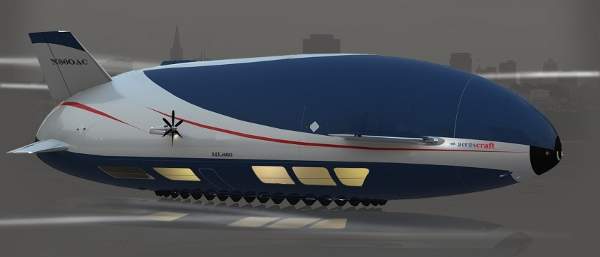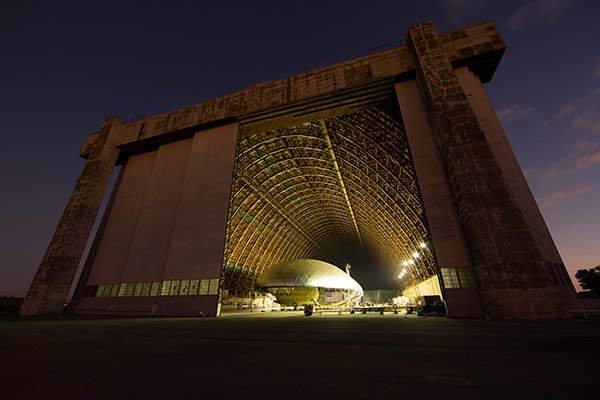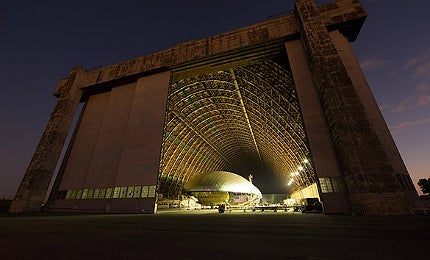Aeroscraft ML866 is the world’s first rigid variable buoyancy air vehicle. It was developed by the Worldwide Aeros Corporation for heavy cargo transportation.
The air vehicle is capable of controlling lift in each stage of flight, from take-off to landing. Unlike airships and hybrid airships, the Aeroscraft ML866 unloads onboard cargo without re-ballasting.
The Aeroscraft ML866 was first unveiled at the National Business Aviation Association (NBAA) show in Atlanta in October 2007. Worldwide Aeros received a design patent for the Aeroscraft from the United States Patent and Trademark office in July 2012.
The company also plans to launch two larger versions of Aeroscraft, designated as ML868 (60t) and ML86X (500t).
Capabilities of the rigid variable buoyancy air vehicle
Aeroscraft can be used in wide range of missions, including heavy lift transportation, search and rescue, emergency relief and airborne medical assistance.
It can also cater to oil and gas exploration and wind energy operations in remote and ecologically sensitive areas. It can deliver cargo and equipment to the working sites with minimal environmental impact.
The air vehicle can support the logistical needs of large wind farms by transporting 10MW wind blades, towers and other components. The internal payload compartment of the aircraft can house multiple blades that are more than 300ft long.
The Aeroscraft aircraft can carry a maximum payload of 20t with no infrastructure requirements.
Design of Aeroscraft’s unique aircraft
The aero-shell with a rigid girder system makes the hull of the vehicle strong. The internal frame of composite truss construction is connected to the external frame. It acts as the main load supporting structure. The hull is reinforced by cables passing between internal and external frames.
The forward section is mounted with two canards, while the aft structure is installed with empennages. The revolutionary structural design provides higher weight efficiency than other airships.
The unique design of the Aeroscraft ML866 incorporates enhanced envelope fabric, digital flight control system and vertical take-off and landing (VTOL) system. The external body of the air vehicle is covered by multilayer composite outer cover.
Aeroscraft ML866 has a length of 310ft and a span of 142ft. It features a large cabin area of 5,382ft2 (500m2). The vehicle can perform VTOL operations while carrying its maximum payload.
Cockpit and avionics of the ML866
Aeroscraft incorporates a retractable cockpit accommodating two crew members. The cockpit features touchscreen flight controls, avionics and modern instrumentation. The Augmented Pilot Vision System provides the crew with an enhanced visual field of view and ensures take-off / landing in zero visibility conditions.
The pilot’s instructions are fed into a flight control processor and transmitted to the surface actuators via fly-by-light (FBL) technology instead of fly-by-wire (FBW) systems. The FBL system eliminates the need for shielding of wires against electromagnetic field (EMF) interference therefore saving on cost and weight.
Technology and landing gear
Aeroscraft is equipped with an Internal Ballast Control system to offload cargo without employing ballast.
The air vehicle uses a full authority direct organic lift control (FADOLC) dynamic buoyancy management system and COSH (control of structural heaviness) system. The COSH system compresses, stores and decompresses the helium inside the envelope to manage the buoyancy of the air vehicle. Helium provides about 70% of the aerodynamic lift and the rest comes from the shape of the air vehicle.
The innovative features and technologies applied in the Aeroscraft ML866 make it superior to other airships and hybrid airships. The Aeroscraft also requires no hangar and maintenance facilities. It can perform hover and low speed flights with decreased fuel consumption.
The air cushion take-off / landing system (ACTLS) allows the Aeroscraft to land on rough and snowy terrains or even on water. The air vehicle performs autonomous landing without an extensive ground crew. The ACTLS at the bottom of the body creates a vacuum to ground the aircraft upon landing.
Engines and performance of Aeroscraft’s ML866
The Aeroscraft air vehicle can hover at speeds up to 120kt and will operate at a maximum altitude of 12,200ft. Its six vectored-thrust turbo-prop engines, providing vertical take-off and landing capabilities, are complemented by the expanded helium for lateral flight. Aeroscraft ML866 has a maximum range of 1,000nmi.
Related content
Kamov Ka-62 Passenger and Cargo Transport Aircraft, Russian Federation
The Ka-62 is a twin-engine medium utility helicopter being designed and manufactured by Kamov Design Bureau of Russia.
Skylon Unmanned Reusable Cargo Spacecraft, United Kingdom
Skylon is an unmanned reusable cargo spacecraft being designed by UK-based Reaction Engines (REL) for the UK Space Agency (UKSA).









